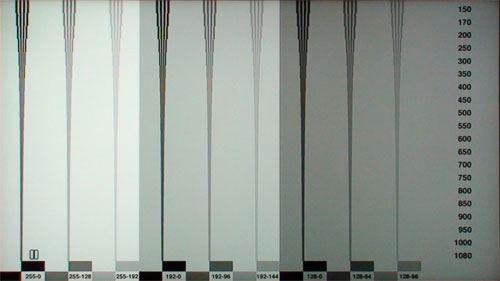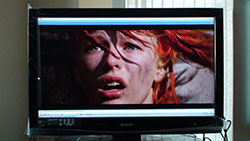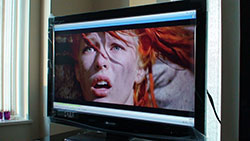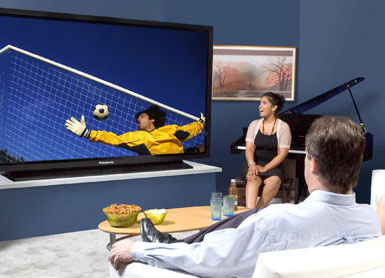The biggest sporting event on earth — the FIFA World Cup 2010 — will kick off in less than 3 weeks’ time. If like us, you’ve not been fortunate enough to snag a ticket to South Africa, there may still be time for you to do the next best thing. Namely buy a brand new flat-screen HDTV, and feast your eyes on Wayne Rooney’s every strand of stubble and every bead of sweat right in your lounge in glorious high definition.

But with so many models available on the market, how should you go about choosing the right HDTV in time for World Cup 2010? Having reviewed more than 80 flat-panel displays over the past 3 years, we’ve decided to distill all the knowledge and experience we gained into 4 essential aspects you need to consider:
Motion Resolution
The HDTVs most suitable for watching football are those that can handle fast on-screen sporting action without excessive motion blur. Here at HDTVTest, something we routinely measure on each HDTV we review is motion resolution, which refers to how well the TV maintains its on-screen resolution during movement. The higher the motion resolution, the less the motion blurring you’ll see on the HDTV.
 |
| The test pattern we use to measure motion resolution on the HDTVs we review |
Even though LCD TVs have made great strides in recent years, generally plasma televisions still deliver some of the highest motion resolution on offer today, making plasma the best display type among flat-screen HD TVs for watching fast-action sports like football. We’ve been really impressed by Panasonic’s 2010 range of plasma TVs (such as the Panasonic S20 and G20 NeoPDP series) which boasts deep blacks, wide viewing angles and virtually no image retention in addition to high motion resolution.
If you prefer to go for LED or LCD TVs because of their typically sleeker styling and lower power consumption, the good news is that some LED/ LCD TVs are equipped with motion-compensated frame interpolation (MCFI) like 100Hz or 200Hz technology which can help them come close to or even match plasma’s motion resolution.
However, these extra motion processing invariably introduces interpolation artefacts into the picture, for example you may notice the ball tearing up slightly as it whizzes past the crowd. In our experience, Sony Bravia LCD TVs equipped with their proprietory 100Hz/200Hz Motionflow system (e.g. the Sony KDL-40EX503U which costs £749 including free delivery from Amazon) exhibits the least motion interpolation artefacts among the major TV brands.
Viewing Angle
If you’re going to invite your mates around to enjoy some World Cup football, then another important attribute you should consider is the TV’s viewing angle.
In this area plasma TVs again reign supreme: like CRT TVs, they exhibit virtually no drop-off in contrast and colours when watched from an angle however acute. This is different from LED/ LCD TVs where blacks start to lighten, and colours begin to fade when viewed off-axis.
 |
 |
| LCD TVs tend to lose contrast and colour saturation when viewed from an angle | |
Some LED/ LCD TVs do fare better than others though depending on the type of panel used. We find that LED/ LCD TVs blessed with IPS (In-Plane Switching) panels (like the Panasonic and LG LED/ LCDs) usually have better viewing angles than those with VA (Vertical Alignment) panels.
Integrated Freeview HD Tuner
Freeview HD transmission was launched in December 2009, adding a few HD channels to its existing standard-def line-up. Although currently the only available high-def channels on Freeview HD are BBC HD and ITV HD, fortunately these are the two channels responsible for broadcasting almost every World Cup 2010 match in high definition so you won’t be missing out (provided you stay in an area with Freeview HD reception… you can check at http://www.freeview.co.uk/availability/main/indexhd/).

If you’re going to buy a new HDTV anyway, it makes sense to choose one with integrated Freeview HD tuner, so all you need to do to enjoy HD World Cup football is to hook the TV up directly to your aerial without needing to install a satellite dish or pay any subscription. Here’s a semi-exhaustive list of HDTV models from the major brands with Freeview HD tuners built-in:
- LG: PK590, PK790, PK990, LD690, LD790, LE5900, LE6900, LE7900, LE8900, LX6900 and LX9900 series.
- Panasonic: S20, G20, V20, D25, D28, VT20 series.
- Philips: No 2010 models with built-in Freeview HD tuners.
- Samsung: C580, C630, C650, C652, C654, C750, C5800, C6000, C6500, C6505, C6510, C6530, C6540, C6600, C6620, C6900, C7000, C8000 and C9000 series.
- Sharp: LE811E and LE821E series.
- Sony: Bravia EX403, EX503, EX603, EX703, NX503, NX703, NX803, HX703, HX803, HX903 and LX903 series.
- Toshiba: RV753, SL753 and WL753 series.
Screen Size/Viewing Distance
While it’s tempting to spend your money on the largest flat-screen HD TV you can afford, your TV’s screen size should primarily be dictated by how far you’re going to sit from the TV. Sit too close and you’ll notice pixelation and other undesirable video artefacts; sit too far and you’ll lose out on seeing the extra detail that HD resolution brings.
 |
| Choose the right TV size depending on your viewing distance |
The resolution of the source material plays an important part as well. If the majority of your viewing is in standard definition then you may have to sit further from the screen to avoid seeing compression and scaling artefacts. HD content (especially Full HD 1920 x 1080 ones) allows you to sit closer to the screen, and enjoy the additional detail and immersive cinematic experience.
Because the quality of scaling/ upconversion on modern HDTVs has improved a lot recently, when watching SD content today you can sit closer to the TV than the viewing distance we recommended a few years ago. With these points in mind, here’s an updated table to guide you on the optimal viewing distance for your TV screen size depending on the source material:
| Screen Size | SD Viewing Distance | HD Viewing Distance |
| 32″ | 6 feet | 4 feet |
| 37″ | 7 feet | 5 feet |
| 40″ | 8 feet | 5 feet |
| 42″ | 8 feet | 5½ feet |
| 46″ | 9 feet | 6 feet |
| 50″ | 10 feet | 6½ feet |
| 52″ | 10 feet | 7 feet |
Happy hunting for your new HDTV, and good luck for whichever country you support!

All Philips models in my country ( Croatia) have hd freevew tuner ( mpeg4 HD)?!
I’m wattching one promo HD channel, on my Philips lcd tv.
@Matt: In the UK, the only way to get High Definition via an aerial is with a DVB-T2 tuner. I believe all other European countries are delivering it using the less efficient DVB-T.
I’m writing this from continental Europe. One thing is not clear to me. Is this “Freeview HD” you speak about in the UK the same thing as MPEG4 DVB-T we have in Europe (DVB-T aerial signal, in HD resolution, compressed with the MPEG4 codec)?
Thanks for the great read Vincent.
I’m leaning towards a plasma now. The only thing I didn’t like about them before was how the picture washes out in a bright room but I’m hoping the new screen filters will improve that now.
Hi Vincent thanks for this guide. You have mentioned the Sony KDL-40EX503U. Would you recomend this tv (for normal viewing/movies/sports) as compared to say a Panasonic lcd. Also are you reviewing the Sony ex503.
Thanks
I have to disagree with the viewing distances,for a 40″ LCD tv.
Last week,I bought a Sony KDL 40HX703 and sit approximately 11 feet away,and the picture is excellent,both in SD and HD.
For extra info,it’s connected to a RHT G-550 stand/sound unit and the sound is great,thought I had to watch a few programmes before I could get a balanced bass sound.
Why it was hard to find this unit,I do not know.I was told that Sony stopped stocking them,because poor sales.
@tonci: No it’s different. As David has explained, Freeview HD is specific to UK, and requires a DVB-T2 tuner to receive it.
@Alex: David is reviewing the Sony 40EX503. The IPS-based panels on Panasonic LCDs tend to deliver cleaner motion for sports sans MCFI, whereas the VA panels on Sony LCDs are capable of deeper blacks which may be important to you for movie watching.
@Steve: Our viewing distance vs screen size table simple serves as a guide. At 11 feet away from a 40-inch screen, you may not be able to make out the extra resolution and detail that HD brings. Have you tried sitting closer to the screen (say, 8 feet away) for a more immersive viewing experience?
Warmest regards
Vincent
Shouldn’t freesat HD tuners also be included in your list; World Cup available in HD nationwide?
@ekol: Yes, a TV with integrated Freesat HD tuner is a valid choice if you already have an existing satellite dish installed. However, as Freeview HD becomes more widely available across the UK, I fear that Freesat HD may become a defunct platform eventually. Certainly among the initial batches of 2010 HDTVs, only some from Panasonic feature Freesat HD tuners.
Warmest regards
Vincent
Hi Vincent, I’m looking at buying the panasonic 42″ G20 with the Built in HD freesat & HD freeview. The trouble is that I don’t have HD freeview in my area at the moment on the area test, but I get standard freeview on my current TV. I have Virgin, not Sky. Is there any way to watch HD freeview.
Cheers
Thanks for the reply Vincent. I bought the Sony ex503 but find it to blurry with movement and its hurting my eyes. When I engage motionflow its makes the image look overly strange and its still blurry. Would a Panasonic lcd be more comfortable for me to watch with movement without using the IFC. Thanks
A great guide thanks, I’ve gone for a samsung 32″c650 myself due to the good motion resolution for an lcd (from your review of the 40″) and so I can use it for a pc monitor too.
A thing about your viewing distance table though, a 52″ screen is 2.64 times bigger than a 32″ screen, we’re talking area here, so surely you should sit 11 feet away for HD content by your numbers? I’ve always thought people over-estimate viewing distances anyway because i think 2 feet or just over should be fine for full hd on a 32″ screen as surely the ideal distance is the closest you can be and not see the pixels? Not meant to be a rant/lecture by the way, apologies.
Hi,
Here in Finland terrestial hd tv standard will be dvb-t2. I think it will the case also in many European countries – no facts though. So far test transmissions has taken place with mpeg4. No dvb-t2 broadcasts yet here. Current models with hdtv support includes mpeg4 tuner. E.g. Panasonic models you have just reviewed in May, includes only mpeg4 tuners.
Do these viewing distances take into account the variable quality in broadcast SD?
While nominally I have a 10.5″ distance from my existing 42″ G15 plasma, I dont think moving to a 50″ would do a lot of material any favours! And for full 16:9 frame material a 46″ would be very “in your face”!
The one benefit I see is for film with black borders, there a 46″ would do nicely!! :-))
….no mention of plasma viewing in bright conditions or screen glare from the
glass fronts??….a very important point which is generally glossed over.
@David Mackenzie
Sweden, Norway and Finland have dvb-t2 for HDTV-material. I do not know how the case was when you gave your comment though, but I believe Sweden had it. They started with dvb-t2 shortly after the european dvb-t2 test broadcasting project financed by EU. The reason for this was the limitation in the Swedish bandwidth reserved to TV.